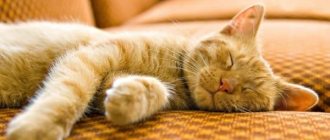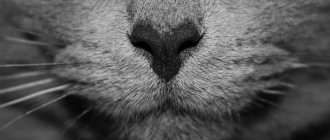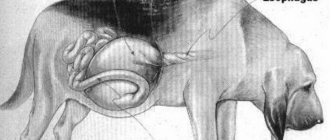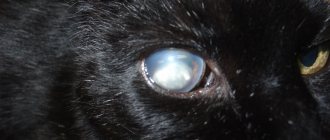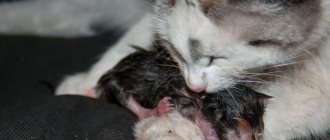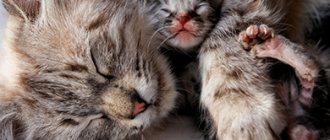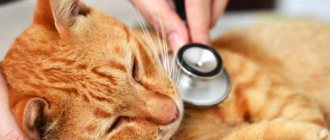Cat owners know that from time to time they have to collect cat hair around the house, as the period of natural hair loss begins. But why do some cats have too much fluffy cover, and even bald patches form near the tail or on the tummy and paws?
Severe hair loss is not normal ; you should definitely pay attention to it and seek advice from a specialist. But don’t be alarmed right away; perhaps the animal is lacking vitamins or this is how a skin disease manifests itself.
The veterinarian will diagnose why the cat’s hair is falling out and bald spots are forming, prescribe treatment, and explain preventive measures. If the cat sheds hair, but new hairs immediately grow, then it’s just shedding season .
Reasons for the appearance of bald spots in cats
Usually, due to illness or other physiological disorders in the animal's body, a bald spot remains on the neck, near the hind legs. Only after an examination at a veterinary clinic can the causes of baldness in cats be determined.
- Cat baldness can appear due to allergies to medications, certain types of food or products, or to hair care products.
- The fur sometimes peels off due to insect bites , but not all cat owners know about this. Flea bites may not go away without leaving a trace, although they are considered something minor.
- If your furry pet's back or other part of the body is peeling, this may indicate that the animal has experienced severe stress - fright, for example, or moving to a new place of residence.
- Among the causes of baldness are endocrine diseases, abdominal trauma, and pyoderma .
- Among the specific causes is feline symmetrical alopecia .
It is necessary to ensure that the cat does not lick the fur on its belly and paws too diligently and often; this can also cause damage to the hair follicles, their weakening, and hair loss.
Alopecia, or feline hair loss: what is it?
All cats shed twice a year, and this is the norm. How to distinguish: is it molting (the process when the fur is renewed) or pathology (baldness of the animal)? To do this, you need to know how the disease manifests itself, what its prerequisites are and in what cases the owner needs to sound the alarm.
Alopecia is the name given to abnormal hair loss in cats, as a result of which bald spots are formed on the animal's body - areas with absolutely no hair. The fur may fall out in clumps, forming bald areas on the animal's head, ears, and paws. Having noticed such areas, the owner should immediately take the pet to an appointment with a veterinarian. Baldness can be a signal of serious problems in the animal’s body.
But this should not be confused with hair loss, which normally occurs in all healthy felines. Cats lose their fur during:
- molting (a seasonal change of “coat” occurs twice a year; cats usually shed more than males);
- stress (the animal may shed some hair due to excitement);
- age-related changes (old animals lose hair and whiskers);
- frequent bathing (this is why it is recommended to bathe the animal only if necessary; twice a year is quite enough).
At the same time, the wool does not come out in clumps, without forming bald spots. But the disease has slightly different symptoms.
Diagnosing the causes of baldness
In order to prescribe treatment for a cat and give its owner recommendations on maintenance, the veterinarian must determine why the bald spot appeared on the neck or paw. The cause is determined by exclusion; this approach requires professionalism from the doctor and attentiveness from the cat’s owner.
INTERESTING! If a problem with fur occurs, you need to carefully examine the cat, its fur and skin. If a cat that has hair on its hind legs has a rash elsewhere on its skin, either small or large, a diagnosis of allergic dermatitis may be possible.
With allergies, the pet owner may experience watery eyes, sneezing, and hair falling out in large clumps. The specialist will prescribe comprehensive treatment.
Such severe baldness is usually observed during an acute allergic reaction. Without eliminating the cause of the allergy, it will not be possible to cope with wool problems.
Baldness due to pancreatitis
It is difficult to imagine that a cat could develop bald patches due to chronic pancreatitis. This disease, even with a sluggish course, is accompanied by diarrhea, indigestion, fatigue and lethargy of the animal. Also, with this disease, the cat becomes bald on the back and other parts of the body.
ATTENTION! The presence of pancreatitis in an animal, due to which its fur on its tail, back, and between its hind legs is thinning, can be determined not only by frequent diarrhea, but also by rumbling in the stomach.
Burn or frostbite
Sudden temperature changes have an extremely negative effect on the condition of the skin. In cold weather, cats try to be closer to sources of heat, and can accidentally burn their paw pads on a stove or heater that has just been turned off.
You might be interested in: What does a lump on a cat’s nipple indicate?
Frostbite threatens a pet that has free access to the street. Of course, it rarely comes to tissue necrosis, but slight peeling is a common occurrence on the paws of a “walking” cat.
Consequences of injury
Observing a cat after it has fallen and been severely injured, you will notice that it has also lost a lot of hair on some parts of its body. Sometimes injuries are visible and easy to diagnose, but they can also be hidden, which is even more dangerous.
Hair loss is sometimes the only visible symptom of internal injuries. Therefore, having detected the appearance of alopecia after a fall of a pet, you need to immediately report this to the veterinarian observing the cat.
Bald spots in combination with fearfulness and wariness quite accurately indicate the stress the cat has experienced. With this state of psychological health, the pet does not want to be handled, does not allow itself to be petted, looks for secluded corners, and may flinch from sharp and loud sounds.
IMPORTANT! As you can see, bald spots on a cat’s body always indicate some kind of health problem, so this symptom cannot be ignored.
Problems with the endocrine system
Alopecia, caused by disturbances in the endocrine system of cats, is not so rare. The specific endocrine disease may vary. Additional symptoms of hypothyroidism are lethargy, sometimes obesity, and decreased body temperature.
With hyperfunction of the adrenal cortex, swelling appears. What bald cats look like due to the endocrine system can be seen in the photos of special sites about feline health; accurate illustrations will help owners quickly recognize the disease in order to begin its treatment.
How to treat hair loss in cats
If a cat has a bald patch on its stomach, hind legs, tail, or if severe hair loss is noticeable, a veterinarian’s help is needed in solving the problem. If such a symptom is ignored, serious diseases can develop into a more complex condition of the animal .
The choice of means and methods of treatment depends on the diagnosis of the cause of the disease.
- Did the bald spot appear at the site of a flea bite? This painful area should be treated with an insecticidal agent. The doctor will recommend which one.
- If you have a food allergy, first eliminate the source of the allergic reaction. At the same time, the veterinarian prescribes antihistamines.
- You may also be allergic to dust, in which case you should do wet cleaning in the house more often, especially in those rooms where your pet spends time.
- If the cause of bald spots is chronic pancreatitis, without curing this disease it is impossible to restore the thickness of the coat. Treatment is aimed at eliminating pain, combating dehydration, and reducing destructive secretions. Swelling should be relieved and pancreatic function should be slowed down.
- In case of hyperthyroidism and hypothyroidism, first of all, it is necessary to restore the balance of thyroid hormones. Treatment of the first disease involves taking medications that also support the functioning of the kidneys and heart and inhibit the production of thyroid hormones. If hypothyroidism is to be treated, medications are needed to slow down the binding of serum proteins.
Only after restoring the balance of hormones can we expect the elimination of bald spots in a cat.
In the most severe cases, the veterinarian decides on surgical intervention. After surgery, the cat owner must feed her according to the prescribed diet, which includes foods with enveloping properties.
Why does a cat go bald?
The hair roots are attached to the hair follicle, which is surrounded by blood vessels and nerve endings. From this it is clear that there are many reasons why a cat’s hair falls out in clumps to bald spots. This could be a metabolic disorder, hormonal, genetic problems, a reaction to parasites, or allergies. That is, when a cat goes bald, the reasons can be either congenital or acquired.
A healthy animal's fur is shiny, smooth, and adheres firmly to the skin. A sign that a cat has alopecia is the appearance of bald patches or the presence of profusely falling hair all over the body (not to be confused with shedding in cats).
Bald patches in cats form in random places or are located symmetrically on the body. The skin around the area of baldness may peel, turn red, have bumpy formations, ulcers, and be hot to the touch.
Based on the places where bald spots appear on a cat, it is possible to determine to some extent what was the cause of baldness.
The most common causes of coat damage are discussed below.
Stress
Nervous disorders lead to the fact that the cat itself begins to tear out its fur in shreds, “gnaw out” fleas, and lick itself so diligently that the fur begins to fall out.
Excessive licking to relieve stress is a compulsive behavior associated with excessive self-grooming. The cat licks its fur down to its bald spots. Some animals even go so far as to chew the skin. This type of alopecia is called psychogenic.
Bald spots appear in the abdomen, genitals, inner thighs, legs, behind the ear, on the back, where the cat reaches with its tongue and paws.
Constantly rubbing your muzzle with your paw can cause acne on your chin.
It is believed that Siamese, Abyssinian, Burmese, and Himalayan cats are most susceptible to psychogenic alopecia. It is typical that in these breeds the color of the coat after restoration in the affected areas will be darker.
Stress in cats is underestimated by many owners. However, too many factors that seem insignificant to the owners can provoke a state of anxiety and neurosis:
- moving to a new home;
- the appearance of another animal or a new family member;
- repair;
- moving the tray to a new location;
- boredom.
Also, if a cat licks its belly until it becomes bald, the reasons for such excessive “self-grooming” may be parasites, allergies, or dermatitis.
Often, owners do not associate the fact that a cat is going bald on its stomach and hind legs with licking. After all, the pet does this mainly when alone. Therefore, if the animal’s behavior has changed, it has become secretive, withdrawn and baldness has appeared – it is urgent to assess its living conditions and identify sources of stress.
Poor diet
When a cat has problems with its fur, the first thing you need to do is take a closer look at its diet. An unbalanced diet, hence the lack of vitamins, quickly affects your appearance. Malnutrition and resulting exhaustion also lead to baldness.
Other causes of bald spots and hair loss
Listed are the main reasons why a cat’s coat may most often thin out. But veterinarians, upon careful examination of the animal, can detect other sources of baldness.
The thickness of the coat in pregnant females changes, and problems with hair can also arise in diseases such as ringworm, solar and neurogenic dermatosis, folliculitis, acne, erythema multiforme .
ATTENTION! All causes are serious and self-medication is excluded. Even if the doctor sends the cat for treatment at home, he will diagnose and prescribe professional, effective treatment.
Diagnosis
In order to correctly prescribe treatment, a veterinarian must make an accurate diagnosis and find out the causes of the black spots on the cat’s chin. This can be done based on clinical and laboratory studies.
First of all, the doctor pays attention to the presence of black spots or spots on the cat’s chin. Next, he makes a scraping from the skin and sends it to the laboratory to exclude dermatomycosis and parasitic diseases (demodex).
If a cat has purulent sores on the chin near blackheads, then a veterinarian will conduct a cytological analysis of the epidermis for the presence of pathogenic microflora.
Preventive measures
Proper prevention often allows you to avoid problems with hair loss.
- You should carefully choose food for your pet, feed it not only dry food, but also high-quality homemade food (vegetables, dairy products, herbs). The diet should contain a lot of vitamins.
- Vaccination is required, taking into account the schedule for a specific breed.
- It is recommended to protect the cat from stress and injury and provide him with the best living conditions.
- Products for hair care and antiparasitic skin treatment are also needed.


